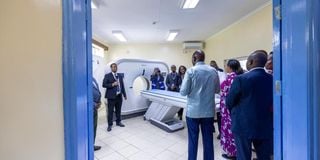All you need to know about new AI-powered CT scan in Nakuru PGH

President William Ruto, Gov Susan Kihika and other leaders during the launch of the a new 128-slice CT scanner at the Nakuru County Referral and Teaching Hospital on October 29,2025.
Residents of Nakuru County will now access faster and more accurate diagnostic services following the installation of a new 128-slice CT scanner at the Nakuru County Referral and Teaching Hospital.
The advanced imaging machine launched by President William Ruto on October 29 at the Nakuru referral and teaching Hospital (PGH) comes into service to substitute the older 64-slice model that had been out of service for quite some months.
This marks a major leap in diagnostic technology for the county, allowing specialists to detect diseases with greater precision and speed.
According to Radiographer-in-Charge Richard Kipkemoi, the new scanner is AI-enabled and ultra-fast, completing a head CT scan in just 0.3 seconds, down from 0.5 to 0.6 seconds, making it several times faster than the previous machine.
“This 128-slice machine gives us sharper images, faster results, and better patient safety. It uses less radiation, which means patients are exposed to lower doses during scans, while giving doctors clearer diagnostic detail,” says Kipkemoi.
Kipkemoi adds that the new technology allows the hospital to perform cardiac CT angiograms- detailed scans of the heart’s blood vessels (coronary arteries) that Nakuru previously could not do.
The procedure requires high-speed imaging because it must capture the heart at a specific phase, during diastole, when the heart is relaxed.
“With low-slice equipment, the image quality of the arteries isn’t clear enough, so we often had to refer patients outside the county,” he explains.

President William Ruto, Gov Susan Kihika and other leaders during the launch of the a new 128-slice CT scanner at the Nakuru County Referral and Teaching Hospital on October 29,2025.
“In private hospitals, a cardiac angiogram can cost up to Sh. 30,000, but with this new machine, it will be done locally and covered under the Social Health Authority (SHA) at between Sh. 6,900 and Sh. 9,000, depending on the type of imaging.”
The 128-slice scanner can handle up to 100 patients per day, double the capacity of the older machine, and will primarily benefit trauma and oncology patients, who make up more than two-thirds of the hospital’s CT workload.
“About 40 per cent of our scans are for trauma cases from road accidents owing to Nakuru sitting in the Northern corridor, while around 30 per cent are for oncology patients who need staging or follow-up imaging. This is followed by the cold or elective cases, and with this upgrade, turnaround time will be shorter and image quality superior,” Kipkemoi notes.
Nakuru currently serves patients from over 10 surrounding counties, a number expected to grow as diagnostic services improve, especially if the status quo remains in those counties (do not get high-end equipment), opines Kipkemoi.
He says the new scanner signals a shift toward greater equity in healthcare, where a public facility can now offer imaging quality that rivals private hospitals, with Nakuru setting a new standard for regional diagnostic care.

